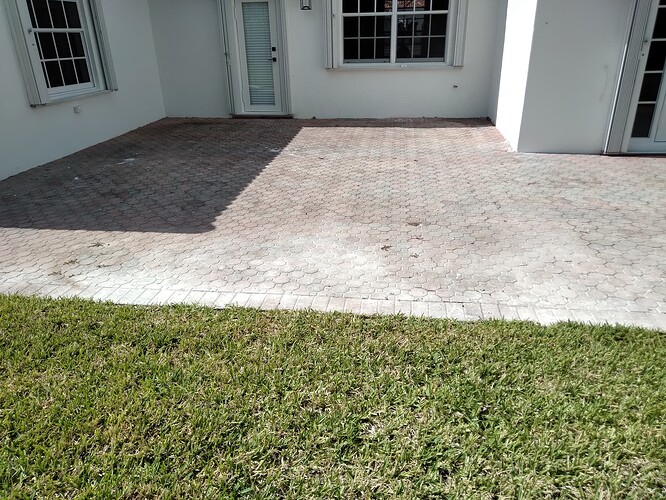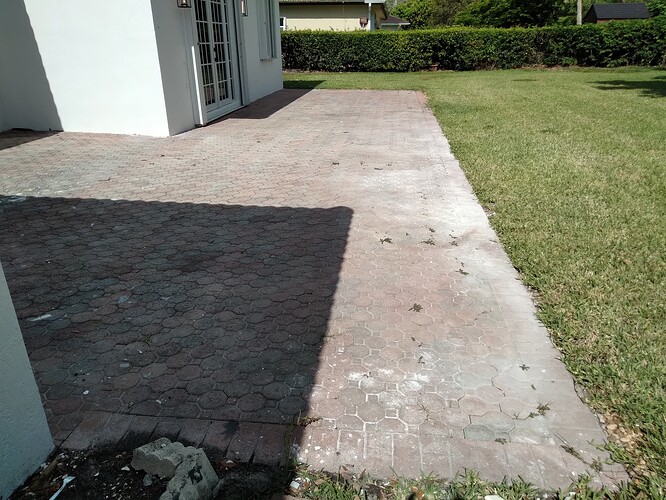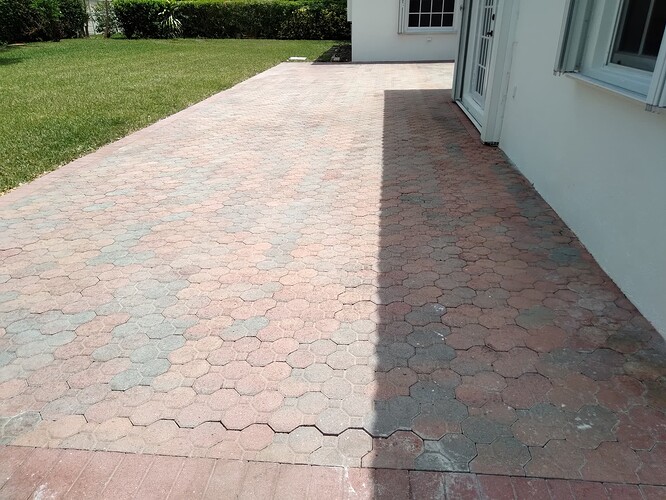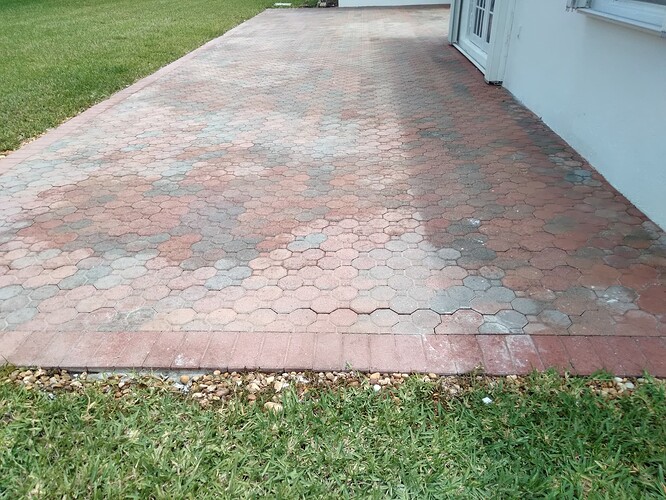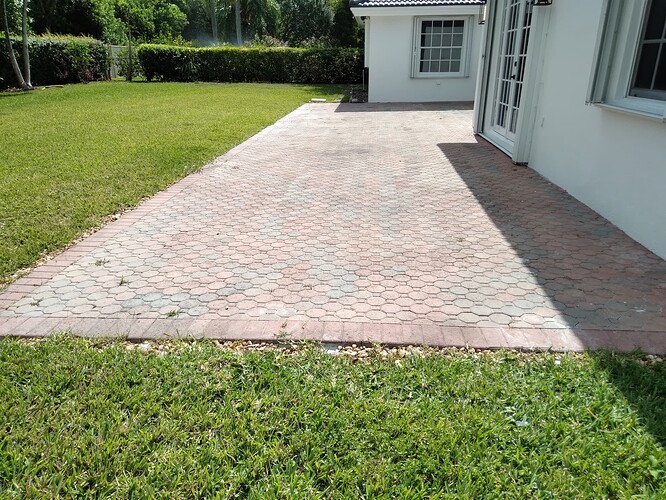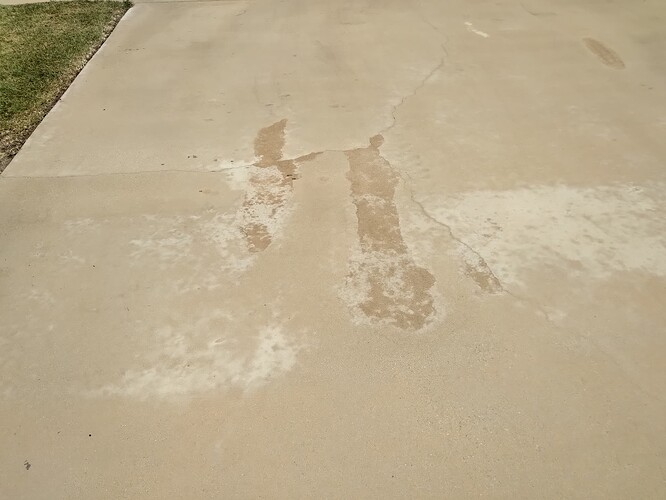Client wanted caulking, thin set, looked like efflo, grease/oil and paint overspray removed from pavers/patio. This is after I cleaned it, they were disappointed. I took extra time and used F9 on some dark spots and pressure wand on some of the paint/caulking for free. It did well on some of those areas, but not perfect. Client didn’t want the front concrete driveway cleaned although it needed it. But probably would have been disappointed with that as well because it had been blasted with high pressure too many times and had discoloration on it. It just wouldn’t have cleaned up as great either. This is all for a S Florida price. Oh well, at least I used the f9 for once it worked. While I was doing the job, the next house over was getting blasted their walls & soffit at close range with high pressure gun. ![]()
Pictures ?
South florida price as in people being cheap as hell ?
It’s saturated here which is why I’m trying to find more services to offer. I don’t want to leave anything on the table. Even if it’s doing extra stain removal or sealing or staining decks they want everything for the cheapest price. Not saying I will give the cheapest price, but just want to be versatile.
Not bad. Just have to get an understanding with them up front as far as expectations, but that’s true with every customer.
Wondering if there’s more I could have done in terms of getting rid of the slop that the painters left on there. I told them muriatic acid.
Maybe, but biggest deal is making sure you spot it and warn thm ahead of time that it likely won’t be coming off. Depending on the type of paint, World’s Best Graffiti Remover may do the trick…
first off, they should have had the painters/masons fix it. As a guy who painted we used things called drop cloths. I actually worked for a general conctractor at one point that had a saying “if I see you paint and there isn’t a drop cloth there you are fired”. Caulk is tough, many variants of caulk from latex to silicone to polys and they don’t all clean up the same. On porous pavers, even if you got on it immediately to clean it there still might be some residue.
I think they had unrealistic expectations, unless you quoted them to make it look like new. I will never remove grease and oil in pavers, just lessen it. Seems like they had champagne tastes on a beer budget.
rather than type what some would call an opinion and leaving, I submit this:
https://gesealants.com/frequently-asked-questions/
GE silicone sealant removal steps for surfaces: (note: wire brushing pavers can leave marks, I would try a stiff nylon brush and toss it afterwards)
Uncured Silicone Sealant
Remove (scrape, wipe, dig out, etc.) the uncured sealant and then scrub the area down with isopropyl alcohol (IPA) to remove any remaining oily residue. Only use solvents in a well-ventilated area and follow all safety precautions and instructions listed on the product label or as otherwise provided by the manufacturer. Safety Data Sheets for GE branded caulk and sealant products are available upon request from us at 1-518-237-3330. When solvents are used, proper safety precautions must be observed.
Cured Silicone Sealant
It is difficult to remove cured silicone from a surface. However, if you must remove it, follow the suggestions below. First, remove as much as possible by cutting/peeling/scraping excess caulk from the surface.
- For ceramic tile, marble, Formica®, fiberglass, etc., use 100 percent mineral spirits (turpentine) and a non-abrasive scouring pad. Test the mineral spirits on a hidden area of the surface to ensure that discoloration will not occur. If discoloration does occur, contact the manufacturer of the surface for further assistance.
- For glass surfaces, carefully use a razor blade within a holder to remove as much as possible, then apply mineral spirits. Remove excess with a towel or other suitable cleaning utensil that will not mark the surface (such as a nonabrasive pad).
- For surfaces that are hard plastics or painted, use rubbing alcohol and a soft cloth. Do not use mineral spirits. Only use these solvents in a well-ventilated area and follow all safety precautions and instructions listed on the product label. When solvents are used, proper safety precautions must be observed.
- To remove sealant from a porous/rough surface (concrete, brick, wallpaper), remove as much of the sealant as possible (same as smooth surface). If necessary, use a wire brush in conjunction with mineral spirits.
NOTE: We do not recommend use of a wire brush to remove sealant from wood surfaces, as doing so could damage the wood. Also, mineral spirits should not be used if the wood has any type of finish on it. Test solvent on a hidden area before applying.
Mineral spirits are flammable and should be used away from sparks, flames, and other sources of ignition. Only use these solvents in a well-ventilated area and follow all safety precautions and instructions listed on the product label. When solvents are used, proper safety precautions must be observed.
Special notes about silicone sealant: There is nothing that will dissolve silicone. If you are reapplying silicone to the area, remove the old sealant, and then clean the area with a disinfectant. If mold or mildew is present, apply rubbing alcohol. Let the area dry before reapplying silicone. Do not use soap to clean surfaces to be sealed because silicone will not adhere to surfaces covered with any soap scum present.
DAP latex caulk
What is the recommended clean-up for DAP® ALEX® acrylic latex caulks?
Before drying, they can be easily removed with soap and water. After the caulk has dried, it will need to be cut or scraped away.
We use PW, you could use that or a putty knife to scrape, soak with water, nylon brush it from pavers, rinse.
DAP Polyurethane
mineral spirits
I just used DAP and GE because they are found at most big box stores and that is what a lot of people use. Some other brands may require other fixes.
I’m ready to just get some muriatic acid and maybe some mineral spirits on hand. Seems like that would cover all the bases. That & F9 products I suppose.
I keep F9 on my rig, but I only use it for concrete (one time for brick). Muriatic is a pretty strong acid compared to the normal PW acids, but you can always cut it. I do have oxalic and citric on my rig, sodium percarbonate, one restore, and some nmd80, oh and another hydrochem concrete cleaner (TY SEAN). Water only dilutes, it doesn’t neutralize, you can use baking soda to neutralize acid. If you don’t neutralize strong acids it can cause some issues besides etching concrete. Everyone films everything nowadays, they can film me neutralizing too. All that sexy for so little, they are getting a bargain ![]()
I didn’t want to start a new thread. But it kind of goes along with this one. I got a call from a client wanting me to come back to reclean their concrete driveway. It came out great but they spilled oil on it. I worked on the oil stains with F9 Groundskeeper and it lightened them up but didn’t remove. I could see some of the area turning white when I left. I explained to the client that it wasn’t going to happen even w/hot water. So they’re going to paint over it. So my comment is that I wonder what hot water would have done on either of the above scenarios.
